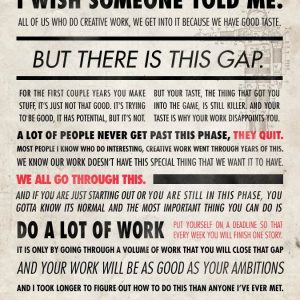We defended the STONE, we found the CHAMBER, we freed the PRISONER, we were chosen by the GOBLET, we fought with the ORDER, we learned from the PRINCE, and we dominated the DEATHLY HALLOWS….”¨We are the POTTER GENERATION…!
The magic isn’t truly in the wand. It is in the pen.
If you’re a Potterhead this has been a bittersweet week and today is massive.
This despite the fact that the Potter movies never truly satisfy real devotees. We know the movies are flawed in story terms, that they leave out essential details and sequences. We can’t imagine how those who haven’t read the books get anything out of them.
Nonetheless we will be there tonight at midnight in costume, with boxes of extra-soft tissue. Tears will be shed.
The Harry Potter books are the ultimate transmedia canon. The story and characters have migrated to every platform and given birth to every form of audience participation imaginable. There’s fan fiction, role playing, cosplay and live events like Leakycon, quidditch matches and midnight parties in bookstores and movies theatres to celebrate each new release.
In my family, we have created a number of rituals around the series. Before every new books was released, we would re-read all the previous books (yes, I have read this series many times and I just finished rereading The Deathly Hallows yesterday). We go in family groups to midnight showings, we wear costumes” we relive the story almost the way we relive the escape of the Jews from Egypt every Passover.
Not to say Harry Potter has become a religion for us, but it is closer to religion than any other media experience I’ve ever known.
What I want to talk about though, is not my own fanaticism but why the Potterverse is the ultimate transmedia experience and what lessons we can apply to our own canon-building efforts.
Harry Potter has traveled to every platform ever created by humankind. And it has engendered unparalleled audience participation. How?
The pundits often talk about creating “gaps” in transmedia narrative for users to fill.
J.K. Rowling didn’t that.
What she did do was imagine a universe of breathtaking breadth and scope. She created dozens and dozens of fully drawn characters, detailed geography with many notable locations, a timeline that spans generations, an epic fantasy tale that includes humour, danger, adventure, mystery, romance and more, plus a deep philosophy.
The incredible detail is what sparks the audience’s imagination and allows them to continue to live within the story universe.
There is a character for everyone. We can call relate to someone — we don’t have to be Harry or even Hermione or Ron. We can be Luna or Neville or even Snape. There are a vast number of characters in the text and each is fully serviced with complete bios and arcs. Consider this description of some of the members of the Order of the Pheonix the first time we meet them in The Deathly Hallows:
Ron, long and lanky; Hermione, her bushy hair tied back in a long plait; Fred and George, grinning identically; Bill, badly scarred and long-haired; Mr. Weasley, kind-faced, balding, his spectacles a little awry; Mad-Eye, battle-worn, one-legged, his bright blue magical eye whizzing in its socket; Tonks, whose short hair was her favourite shade of bright pink; Lupin, greyed, more lined; Fleur, slender and beautiful, with her long silvery blonde hair; Kingsley, bald, black, broad-shouldered; Hagrid, with his wild hair and beard, standing hunch-backed to avoid his head hitting the ceiling and Mundungus Fletcher, small, dirty and hangdog, with his droopy basset hound’s eyes and matted hair.
There are no minor characters in Rowling’s writing. And that’s key.
Then there are the world building details that can be brought to life with real world objects: wands, prefect buttons, robes, butter beer, house colours, time-turners and sneak-a-scopes… make your own or buy the pre-packaged swag. It doesn’t matter to an avid fan, it’s all in service of recreating the story world.
Think of the timeline — the stories start when Harry turns 11 and end about 9 months after his 17th birthday. But Rowling takes us back in time — to Harry’s childhood, to his parents’ childhoods and schooling, to Dumbledore’s youth — and forward to Harry sending his own kids off to Hogwarts. And there is a full cast of characters for every phase of the tale. Albus, Abberfoyle, Ariana and Grindelwald from Dumbledore’s youth. Wormtail, Lupin, Snape and Sirius from James and Lily’s days are Hogwarts.
Engaged Potterheads role-play and write fan fiction about Harry’s kids, about what happened at Hogwarts when the “trio” were out fighting horcruxes, about the marauders’ days at Hogwarts. They relive events in the shoes of characters other than the trio bringing the narrative to life in new ways — playing out the story as Lavender Brown, Mrs. Weasley.
Rowling tells an epic tale. Good vs. evil. Life vs. death. Her themes are the hugest there are. And this too contributes to how engaged the audience is.
So what are the lessons?
- Lots of characters each with complete biographies and arcs.
- A detailed geography with iconic places.
- A past, a present and future (populated with people)
- World building details in the form of food, costumes, objects and games.
- Epic storytelling that crosses genres and doesn’t shy away from life and death events.
- Big themes.
But boiled down to just one thing: detail. It is the detail of Potterverse that it’s most ardent fans love, the detail of J.K. Rowling’s vision that brought her world to life for all of us to share.


